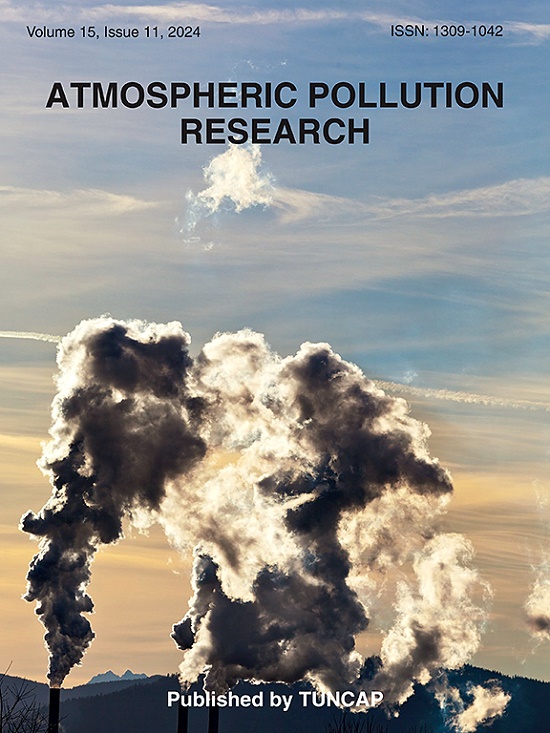Variations in polycyclic aromatic hydrocarbons concentrations and their contribution to aerosol optical depth during the COVID-19 outbreak: A study in Yokohama using generalized additive model
IF 3.9
3区 环境科学与生态学
Q2 ENVIRONMENTAL SCIENCES
引用次数: 0
Abstract
The severe social restrictions aiming at reducing the novel coronavirus disease (COVID-19) transmission during its outbreak significantly affected regional air quality. This study analyzed changes in polycyclic aromatic hydrocarbons (PAHs) concentrations in cyclone-collected powder form particulate matter (PM) samples collected in Yokohama, Japan, from 2018 to 2023. The annual mean ∑PAHs concentration decreased significantly from 20.7 ng/mg in 2019 to 13.2 ng/mg in 2020 after the outbreak. However, the main sources of PAHs remained stable and were dominated by incomplete fossil fuel combustion. A generalized additive model was utilized to analyze the statistical relationships of air pollutants, namely, aerosol particulate matter (PM2.5), ∑PAHs, ozone (O3), metal, and meteorological factors such as solar radiation and their impact on aerosol optical depth (AOD). AOD remote sensing data collected by the Terra/MODIS satellite reflects the degree of air turbidity and atmospheric aerosol loading. Despite the small sample size, the model fitting demonstrated a good fit and showed smoothing non-linear interaction effects among the target factors influencing secondary aerosol generation. In conclusion, intense solar radiation, high concentrations of oxidative gases, elevated levels of organic contaminants in aerosols, and the catalytic degradation of PAHs by transition metals contribute to increased atmospheric aerosol loads. This finding enhances the present understanding of the photochemical reaction processes of aerosol particles. However, longer-term observational studies are needed to confirm our findings due to the limited sample size in this study.

COVID-19疫情期间多环芳烃浓度变化及其对气溶胶光学深度的贡献:横滨地区使用广义加性模型的研究
新型冠状病毒病(COVID-19)疫情期间为减少传播而采取的严格社会限制措施,对区域空气质量产生了重大影响。本研究分析了2018年至2023年在日本横滨收集的旋风收集的粉末形式颗粒物(PM)样品中多环芳烃(PAHs)浓度的变化。疫情发生后,年平均∑PAHs浓度从2019年的20.7 ng/mg显著下降至2020年的13.2 ng/mg。然而,多环芳烃的主要来源保持稳定,并以化石燃料不完全燃烧为主。采用广义加性模型,分析了气溶胶颗粒物(PM2.5)、∑PAHs、臭氧(O3)、金属和太阳辐射等气象因子对气溶胶光学深度(AOD)的影响。Terra/MODIS卫星收集的AOD遥感数据反映了空气浊度和大气气溶胶负荷。尽管样本量较小,但模型拟合效果良好,并显示了影响二次气溶胶产生的目标因子之间的平滑非线性相互作用。总之,强烈的太阳辐射、高浓度的氧化气体、气溶胶中有机污染物水平的升高以及过渡金属对多环芳烃的催化降解导致了大气气溶胶负荷的增加。这一发现加强了目前对气溶胶粒子光化学反应过程的认识。然而,由于本研究样本量有限,需要更长期的观察研究来证实我们的发现。
本文章由计算机程序翻译,如有差异,请以英文原文为准。
求助全文
约1分钟内获得全文
求助全文
来源期刊

Atmospheric Pollution Research
ENVIRONMENTAL SCIENCES-
CiteScore
8.30
自引率
6.70%
发文量
256
审稿时长
36 days
期刊介绍:
Atmospheric Pollution Research (APR) is an international journal designed for the publication of articles on air pollution. Papers should present novel experimental results, theory and modeling of air pollution on local, regional, or global scales. Areas covered are research on inorganic, organic, and persistent organic air pollutants, air quality monitoring, air quality management, atmospheric dispersion and transport, air-surface (soil, water, and vegetation) exchange of pollutants, dry and wet deposition, indoor air quality, exposure assessment, health effects, satellite measurements, natural emissions, atmospheric chemistry, greenhouse gases, and effects on climate change.
 求助内容:
求助内容: 应助结果提醒方式:
应助结果提醒方式:


